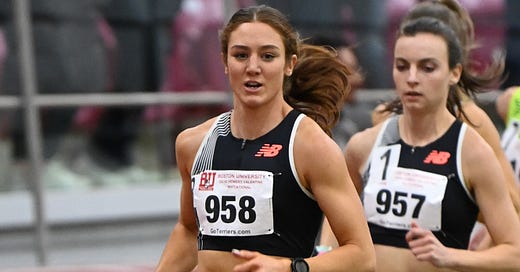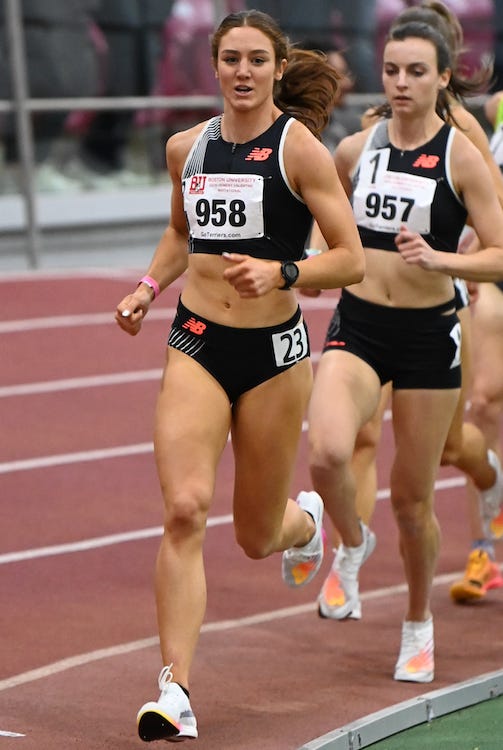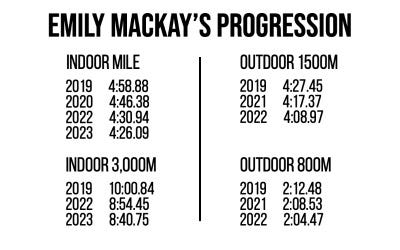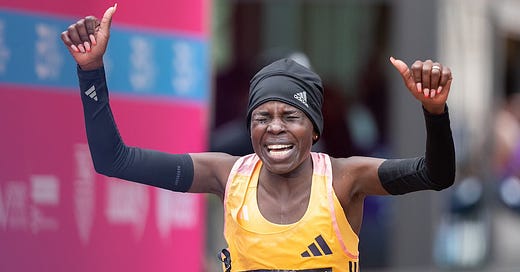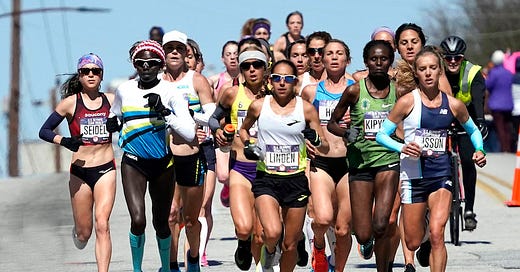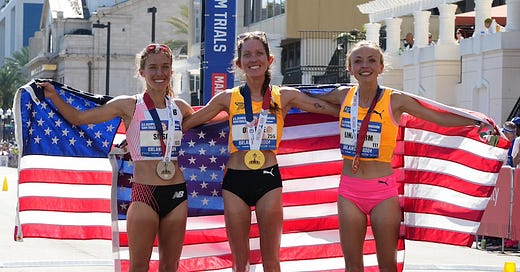

Discover more from Fast Women
Fast Women: Emily Mackay's progress
A look at how to qualify for the Olympic marathon in the U.S.
Issue 238, sponsored by New Balance
After overcoming slump, Emily Mackay has been on a roll
This feature is sponsored by New Balance.
Emily Mackay’s talent on the track has long been apparent. As a junior at New York’s Union-Endicott High School, she ran 4:25.32 in the 1500m at the 2015 New York State Meet to finish second in a thrilling race with Sammy Watson, who is also a professional runner now. But iron deficiency, followed by a persistent injury, led Mackay to lose fitness and confidence in her abilities, and it took several years for her to work her way back. Now that she has, the first-year professional runner for Team New Balance Boston is on fire.
Mackay, 25, has been running massive PRs in recent years, and her dramatic improvement makes more sense once you know her story. But first, it’s important to know that Mackay is pronounced Mc-EYE. It’s a name most people, including race announcers, tend to get wrong.
Mackay achieved her 4:25 1500m as part of a low-key high school program, running 20 miles per week, maximum. There were some intense track workouts, but a standard day of training involved 2–3 miles of running. Mackay’s senior year, she kept getting slower, which only made sense when she learned of her iron deficiency, after her track season was over. She took some time off and supplemented with iron, but while ramping her training back up she developed a toe injury that went on for months.
Mackay arrived at Oregon State injured, and after a couple months, she stopped trying to run and crosstrain altogether. She was homesick, she wasn’t enjoying running, and she decided to transfer home to Binghamton University, thinking she could be happy there whether she was running or not.
Mackay enrolled at Binghamton in the fall of 2017, unsure if she would ever run as fast as she did in high school. And at first, she didn’t give running her best, as a coping mechanism. “[My high school] time, 4:25, seemed very intimidating to me, as someone who couldn’t break 5:00,” she said. “I didn’t want to go all in, because then if I failed, it would feel worse than if I was like, ‘Oh, but I wasn’t trying that hard anyways.’”
By the spring of 2019, she was running times similar to those she had run in high school. But it wasn’t until early in 2020 that she really decided to see how good she could be, both academically and athletically. “I just had this epiphany of, like, ‘What am I doing?’” she said. “I think it was my friend group that really inspired me to just start going all in, and I noticed huge results pretty quickly, both in classes and running.”
Academically, that meant spending more time studying. Athletically, that meant making sure to stretch and foam roll, and focusing on nutrition for the first time in her life. She took a nutrition class that helped her realize how much getting all the nutrients she needed would help with her running.
She had been nervous about increasing her mileage due to past niggles during cross country season, but Mackay also began running more. When the pandemic shut down her season, she stopped doing workouts, which made it easier to get more miles in. “During Covid, running was just the best part of my day, and I kind of fell in love with it again,” she said.
By the end of college, Mackay was running 50–55 miles per week—not high mileage compared to many of the athletes she was racing against, but it was a significant jump from the 35–40 she had been doing and the 20 she did in high school.
When Mackay returned to racing, her performances skyrocketed. In March 2021, she finished 14th at the NCAA Cross Country Championships, earning her first of three first-team All-America honors. She ran 4:30.94 for the mile, 8:54.45 for 3,000m, and capped her career with her highest NCAA finish, taking sixth in the 1500m at the 2022 NCAA Outdoor T&F Championships in 4:11.10.
By the end of a long season of trying to run fast enough to earn a pro contract, Mackay was feeling pretty burned out. But when she lined up for the USATF Outdoor Championships less than two weeks later, wearing the New Balance kit for the first time, the pressure was off. She had achieved her dream. “It just felt like the moment where everything I had been working so hard for all year had finally happened,” she said. “Here I was, lining up as a professional runner for the first time. Nothing beats that feeling. I just felt super thankful to be there.”
She knocked her pro debut out of the park, lowering her 1500m PR to 4:08.97 in the prelims and then finishing seventh in the finals. The fact that she was racing in carbon-plated spikes for the first time didn’t hurt, either.
New Balance Boston was Mackay’s top choice because of its proximity to home, the fantastic training partners (including Olympians Heather MacLean and Elle St. Pierre), and the opportunity to be coached by Mark Coogan. And she is pleased by how tight-knit the team is. “There’s just pretty good vibes on this team,” she said. “It feels like a true team environment, even though we’re obviously all really super competitive individuals. We’re able to function as a team in a very cooperative way.”
The move to pro running has been challenging at times. The team does regular altitude camps in Flagstaff and workouts at altitude hurt in a whole new way. But her body is responding well. Figuring out which shoes were best for her also took a while. She thought she needed a stability shoe, but testing in New Balance’s research lab revealed that she actually has a neutral footstrike. (She now runs most of her easy miles in the New Balance 880s.)
Her hard work is paying off. In February, Mackay became the 100th American woman to break 4:30 in the mile, going well under with a 4:26.09 mile indoors. Six days later, she won a 3,000m with a 13-second PR of 8:40.75. And the week after that, she earned bronze in the 3,000m at the USATF Indoor Championships in Albuquerque (around 5,000 feet above sea level), behind two athletes who have lived and trained at altitude for years. The outdoor season is just getting started, but she has already taken 28 seconds off her 5,000m PR, running 15:14.31 on May 6 at the Track Fest.
Mackay is now running 70–75 miles per week, another big jump. She appreciates that Binghamton coach Annette Acuff brought her training along gradually and left room for growth. And she thinks that by choosing a smaller school, she received more individualized coaching, with less pressure to do anything extreme to help the team. “She wasn’t putting us in three different events and killing us at the conference meet before trying to run regionals,” she said. “I feel like I have a lot of room to grow, and I’m not coming out of college already having reached my full potential.”
Mackay’s times have dropped so quickly that sometimes her brain has to catch up with what her legs and lungs can do. “Though I do feel like I belong, it’s a different mental game lining up against professionals, as opposed to lining up collegiately,” she said. “I think I have a lot of room to grow, mentally.”
This year, she hopes to get her 5,000m time as close to 15:00 as possible, and she’s shooting for a 4:03 or faster in the 1500m. She plans to race the 1500m at Friday’s USATF Distance Classic, and she’s still figuring out her next race after that. It won’t be a surprise if her times keep coming down. “I know it’s obviously going to keep getting harder and harder to [make large jumps],” she said. “But I think that if I keep going on the path that I’ve been on, it’s possible.”

How to make the U.S. Olympic marathon team
Coach James McKirdy posted this thread on Friday about the U.S. Olympic marathon qualifying process. Apparently the information it contained was news to a bunch of pros and Trials qualifiers, and not news to others, but it also confused a lot of people, so I’m going to attempt to explain what it means for the U.S. women.
The Olympic Standard is 2:26:50. Anyone who hits the standard on an eligible course (races like Boston and CIM don’t count because of their elevation loss) or finishes in the top five at a Platinum Label marathon is considered to have the Olympic standard. There are 15 Platinum Label marathons this year, and they include all of the World Marathon Majors.
In the past, in the U.S., having the Olympic standard meant that if someone finishes in the top three at the Trials, they make an Olympic team. It still means that on the track.
As of now, only five U.S. women have the Olympic standard in the marathon: Aliphine Tuliamuk, Emma Bates, Betsy Saina, Lindsay Flanagan, and Susanna Sullivan. (The window didn’t open until November 1, 2022.)
Now stick with me here, because this is where it really gets confusing. World Athletics announced a system last year, where countries can choose to reallocate an available spot on the Olympic team to an athlete without the standard, as long as they’ve run 2:29:30 or faster (on an eligible course). The U.S. has already earned its maximum of three spots on the women’s side.
The part that was news to me in McKirdy’s thread is that USATF has decided to go ahead and take advantage of the reallocation system. So when the first three women—Tuliamuk, Saina, and Flanagan—hit the Olympic standard, it gave the U.S. three Olympic slots. No other U.S. women needed to hit the standard after that, as long as they had run 2:29:30.
This might seem unfair to those athletes—they earned those spots! But by using the reallocation system, it guarantees that the first three women across the finish line at the Olympic Trials will be on the team, as long as they’ve run 2:29:30 or faster on an eligible course. And that makes the Trials more interesting, because a lot more people will have a shot at the team. Unless you’re one of those five athletes, this is generally good news.
So instead of gunning for 2:26:50 or faster, which a fair number of athletes have been doing, the magic number for U.S. women hoping to make the team is 2:29:30 or faster.
It’s likely to take 2:29:30 or faster just to finish at the top three at the Trials, unless the weather in Orlando is highly unpleasant for running, which is entirely possible. Especially because there’s talk of the race’s start time being something TV-friendly, rather than what’s most pleasant for the athletes.
There are mentions of world rankings in McKirdy’s thread. That applies only to the U.S. men, because none of them have hit their Olympic standard (2:08:10).
It would be so much simpler if World Athletics decided that each country could send their three best marathoners. There’s plenty of room on the roads for that many runners, but their target field size, 80 athletes, is much smaller than that.
Thanks to New Balance for sponsoring Fast Women
My favorite New-Balance-related content from the past week is this video from Laura Green. I don’t know if she has solved the mystery yet, but I really hope it’s intentional.I am always curious about how runners rotate shoes and the different things they use them for, so I asked Emily Mackay which shoes she wears when. Here’s her lineup:
As mentioned above, she wears the 880s for a lot of her easy running
But she also wears the Fresh Foam X More v4, a higher cushion shoe, any time she has a short run—like her second run of the day or warmups or cooldowns for workouts. She thinks rotating shoes has made her a stronger and more durable runner.
She wears the FuelCell Rebel v3 for a lot of her workouts—tempo runs, and longer reps on the track, like anything 800m and up, and even 400s sometimes. She frequently wore trainers during her workouts in college, so she has been cautious about suddenly doing a lot of workout mileage in flats and spikes.
She races in the FuelCell SuperComp LD-X, but she only wears spikes during workouts when she’s doing really fast speedwork.
Other News and Links
Talya Minsberg wrote a touching and sad piece about Olympic medalist Tori Bowie’s life and death for The New York Times (gift link).
Val Constien said that when she landed badly during the Doha Diamond League steeplechase, she unfortunately tore her ACL. She’ll be having surgery on it soon.
Cindy Kuzma wrote a second story about the investigation into the University of Colorado’s cross country program, sharing more athletes’ experiences. I particularly appreciated Carrie Verdon’s thoughtful comments at the end of the article. The topic has been a divisive one among CU alumni, which has led to some athletes being understandably scared to publicly speak about their experiences. (Runner’s World).
Sydney McLaughlin-Levrone and Athing Mu, two of the headliners for Saturday’s LA Grand Prix, have had to pull out of the meet. Bobby Kersee told Scott Reid (paywall) that McLaughlin-Levrone’s hamstring flared up during biomechanical testing during a recent training camp in Arizona. She said in her Instagram stories that she was sad not to be racing, but she’s looking forward to opening her track season in a few weeks. And Mu’s training was going well, but she just had Covid. Because both athletes are already qualified for this summer’s World Championships, as defending champions in the 400mH and 800m, McLaughlin-Levrone will run the flat 400m at USAs and Mu will run the 1500m. Kersee said Mu will ultimately need to run 3:59 or faster in the 1500m if she wants to have a shot at breaking the 800m world record of 1:53.28. He also said Mu running the 1500m/800m double at the 2024 Olympics, if the schedule allows it, is a possibility. Right now, Mu’s 1500m PR is 4:16.06, but she hasn’t focused on the event or run it often.
Sara Hall, Keira D’Amato, and Kara Goucher shared their thoughts about why American women are having such success extending their running careers.
Results Highlights
Hellen Obiri is already back to racing after winning the Boston Marathon less than five weeks earlier. She won the Great Manchester Run 10K in 31:14. Fellow Kenyan Peres Jepchirchir finished a distant second, in 31:59. (Results)
Weini Kelati traveled to London with hopes of running 30:40.00 or faster and earning a World Championships/Olympic qualifying time in the 10,000m at the Night of 10,000m PBs. She didn’t quite get there, but she finished second in a PR of 31:04.16. Ethiopia’s Mizan Alem Adane, who is only 21, dominated the race, running 29:59.03, and Jess Warner-Judd (fourth, 31:09.28) won the British title. Only three U.S. women have the world standard at the moment: Alicia Monson, Elise Cranny, and Karissa Schweizer. (Results)
Ethiopia’s Tsehay Gemechu won the TCS World 10K Bengaluru in 31:38.
Ajee’ Wilson won the 800m and earned $8,000 at the Trials of Miles Track Night NYC, running 2:01.28. The time was nothing flashy after a not particularly aggressive start, but Wilson’s pace changes within the race make her tough to beat. Alexina Teubel looked fantastic winning the 1500m by more than five seconds, in 4:07.68. Mexico’s Alma Cortés finished second to Teubel in 4:12.89, and then won a close race with Marielle Hall in the 5,000m later in the night, 15:30.68 to 15:31.47. And India’s Parul Chaudhary won the steeplechase in 9:41.88. (Results)
Running her first 800m since returning from injury, Olivia Baker picked up a win in windy conditions at the USATF Bermuda Grand Prix, running 2:03.15. It was a dramatic race as she held off Uganda’s Susan Aneno by 0.02 seconds. In the long jump, Tara Davis won an exciting showdown with Quanesha Burks on her final jump. (Results)
Japan’s Nozomi Tanaka won the Seiko Golden Grand Prix 1500m in 4:11.56, and Dani Jones finished second in 4:12.12. Kenya’s Teresia Muthoni Gateri won the 3,000m in 8:43.81. (Results)
Maggie Montoya won the Brooklyn Half Marathon in 1:11:38. I was surprised that Montoya said it was her first time ever breaking a finish line tape, but I suppose it depends on the types of races one runs.
Spain’s María Pérez set a pending world record of 2:37:15 in the 35K race walk in the Czech Republic on Sunday. That’s 7:13/mile for 21.748 miles. Walking.
Podcast Highlights
Angel Piccirillo was great on More Than Running. She talked about being part of four different training groups, mostly due to factors beyond her control, since leaving the NCAA in 2017. She had a lot of good insights and came across as being very level headed.
On the Citius Mag podcast, Betsy Saina said that she was planning to stay in the U.S. to race Bolder Boulder after winning the USATF 25K champs, but she missed her son too much, so she decided to return to Kenya. She’s hoping to go after the American marathon record this fall.
On the Sportfire Podcast Colleen Quigley mentioned (right at the beginning) that she and her training partner (presumably Katie Camarena) have a project in the works that will help young athletes who are looking to go pro but need more guidance.
Steph Bruce and Ben Rosario’s discussion of shoe technology on I’ll Have Another was interesting. They were honest about the fact that it was frustrating when other athletes had access to super shoes and Hoka athletes did not.
I really enjoyed hearing some of Julia Brownell’s story on the Ali on the Run Show. Brownell isn’t a pro runner, but she’s a 3:16 marathoner, and she balances her running with parenting and working as a writer on shows including This Is Us and Parenthood.
Upcoming
Friday’s LA Distance Classic will stream live on RunnerSpace starting at 5:00 p.m. ET, and Saturday’s LA Grand Prix will be on NBC at 4:30 p.m. ET. The meet schedule is here and entrants for Saturday’s events are here.
The second Diamond League meet of the season takes place on Sunday in Rabat. The entries are already out and in addition to the usual lineup of superstars, Americans Elise Cranny and Cory McGee will run the 1500m, and Raevyn Rogers and Sage Hurta-Klecker will run the 800m. The meet will stream on Peacock at 2:00 p.m. ET. (Update: It looks like Cranny and Rogers have scratched since Sunday evening, when I wrote this.)
The NCAA East and West First Rounds start on Wednesday for the men and Thursday for the women. This page has links to the schedule, results, entries (in the programs), and the links to watch on ESPN+.
Thanks again to New Balance for supporting Fast Women and to everyone who keeps this newsletter going via your support on Patreon and Venmo. I hope you all have a good week.
Alison


